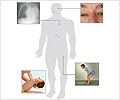Symptoms and Signs
Clinical presentation of Von Gierke disease is usually soon after birth but can be a little later.
Features of neonatal hypoglycemia (low blood sugar) occur shortly after birth. Symptoms include:
- Tremors
- Irritability
- Cyanosis: A bluish discolouration of the skin and mucous membranes
- Seizures
- Apnea: Transient cessation of respiration
- Coma: A state of deep and often prolonged unconsciousness
Von Gierke disease can also present as lactic acidosis during the neonatal period. Lactic acidosis is a condition characterised by the accumulation lactic acid in the blood stream. It can also produce convulsions (seizures).
Abnormal enlargement of the liver (hepatomegaly) occurs by 3-4 months of age. Children with Von Gierke Disease usually have doll-like faces with fat cheeks, relatively thin extremities, short stature, and a protuberant abdomen that is due to massive hepatomegaly.
A short fast can lead to low blood glucose levels and lactic acidosis.
Easy bruising and nose bleeding can occur due abnormalities with platelets (specialized cells required for blood clotting). Recurrent infections due to bacteria and oral ulcers are common in type 1b patients. Patients with Von Gierke disease can also develop intermittent diarrhea that worsens with age.






